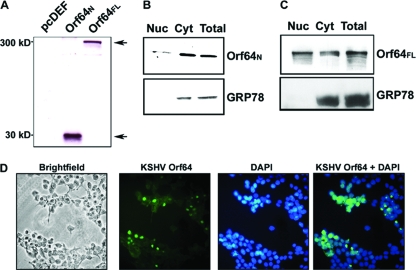FIG. 2.
Expression and intracellular localization of Orf64. (A) HEK-293 cells were transiently transfected with expression vectors for Flag-tagged Orf64N and Orf64FL. Cells were harvested, and the lysates were subjected to Western blot analysis with an anti-Flag antibody. Orf64N displayed a mobility of ∼30 kDa, and Orf64FL displayed a mobility of ∼300 kDa. (B) Transiently transfected cells expressing Orf64N were subjected to cellular fractionation. The N terminus of Orf64 was present in both the cytoplasm (Cyt) and nucleus (Nuc). Expression of the cytoplasmic marker GRP-78 (bottom) served as a control for the fractionation. (C) Transiently transfected cells expressing Orf64FL were subjected to cellular fractionation. Orf64FL is also detected in both cytoplasmic and nuclear compartments. Expression of the cytoplasmic marker GRP-78 (bottom) served as a control for the fractionation. (D) 293T cells in glass-bottom plates were transiently transfected with a Flag-tagged Orf64FL expression plasmid. Forty-eight hours later, cells were fixed in an acetone-methanol (1:1) mixture. Cells were stained with fluorescein isothiocyanate-conjugated Flag antibody and DAPI nuclear stain. Images were taken on a Zeiss Axiovert 200 inverted microscope using Openlab software. All images shown are at 20×.

